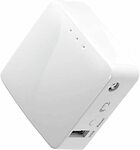[MINI TRAVEL ROUTER]: Convert a public network(wired/wireless) to a private Wi-Fi for secure surfing. Tethering, 3G/4G USB Modem Compatible. Powered by any laptop USB, power banks or 5V DC adapters (sold separately). 39g (1.41 Oz) only and pocket friendly.
[OPEN SOURCE & PROGRAMMABLE]: OpenWrt pre-installed, DDWrt supported. USB disk and WebCam extendable.
[OPENVPN CLIENT & TOR]: OpenVPN client pre-installed, compatible with 20+ VPN service providers. TOR firmware available for downloading.
[LARGER STORAGE & EXTENSIBILITY]: 64MB RAM, 16MB Flash ROM, dual Ethernet ports, UART and 2.54mm standard GPIOs available for hardware DIY.
Interface 1 WAN, 1 LAN, 1 USB2.0, 1 Micro USB (power), 1 Reset button
CPU Atheros9331, @400MHz SoC
Memory / Storage DDR2 64MB / FLASH 16MB
Protocol IEEE 802.11b/g/n
Wi-Fi Speed 150Mbps (2.4GHz)
Ethernet Port 10/100M
LEDs Wireless status and power supply
Power Consumption <1.5W



 CamelCamelCamel
CamelCamelCamel

I think the yellow one (mango) is better right?